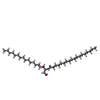+Search query
-Structure paper
| Title | Metabolic signaling of ceramides through the FPR2 receptor inhibits adipocyte thermogenesis. |
|---|---|
| Journal, issue, pages | Science, Vol. 388, Issue 6746, Page eado4188, Year 2025 |
| Publish date | May 1, 2025 |
 Authors Authors | Hui Lin / Chuanshun Ma / Kui Cai / Lulu Guo / Xuemei Wang / Lin Lv / Chao Zhang / Jun Lin / Daolai Zhang / Chuan Ye / Tengwei Wang / Shenming Huang / Jifei Han / Zihao Zhang / Junyan Gao / Mingxiang Zhang / Zhao Pu / Fengyang Li / Yongyuan Guo / Xiaojun Zhou / Chengxue Qin / Fan Yi / Xiao Yu / Wei Kong / Changtao Jiang / Jin-Peng Sun /   |
| PubMed Abstract | Ceramides play a central role in human health and disease, yet their role as systemic signaling molecules remain poorly understood. In this work, we identify formyl peptide receptor 2 (FPR2) as a ...Ceramides play a central role in human health and disease, yet their role as systemic signaling molecules remain poorly understood. In this work, we identify formyl peptide receptor 2 (FPR2) as a membrane receptor that specifically binds long-chain ceramides (C14 to C20). In brown and beige adipocytes, C16:0 ceramide binding to FPR2 inhibits thermogenesis through G cyclic adenosine monophosphate signaling pathways, an effect that is reversed in the absence of FPR2. We present three cryo-electron microscopy structures of FPR2 in complex with G trimers bound to C16:0, C18:0, and C20:0 ceramides. The hydrophobic tails are deeply embedded in the orthosteric ligand pocket, which has a limited amount of plasticity. Modification of the ceramide binding motif in closely related receptors, such as FPR1 or FPR3, converts them from inactive to active ceramide receptors. Our findings provide a structural basis for adipocyte thermogenesis mediated by FPR2. |
 External links External links |  Science / Science /  PubMed:40080544 PubMed:40080544 |
| Methods | EM (single particle) |
| Resolution | 3.2 Å |
| Structure data | EMDB-38964, PDB-8y62: EMDB-38965, PDB-8y63: EMDB-61484, PDB-9jhj: |
| Chemicals |  ChemComp-16C:  PDB-1lxr:  ChemComp-18C: |
| Source |
|
 Keywords Keywords | MEMBRANE PROTEIN / Ceramide / GPCR |
 Movie
Movie Controller
Controller Structure viewers
Structure viewers About Yorodumi Papers
About Yorodumi Papers









 homo sapiens (human)
homo sapiens (human)